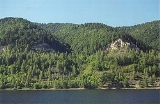
Zhiguli Mountains
Encyclopedia
The Zhiguli Mountains or simply Zhiguli , sometimes called Zhiguli Height - Жигулëвская возвышенность [Zhigulyovskaya vozvyshennost], are a range of wooded mountains located in Russia
on the right bank of the Volga River
, in the Samara bend
. The mountains are an important source of oil
, being extracted since the Great Patriotic War. Altitude up to c. 1,240 ft (380 m). They are named for a nearby town Zhigulyovka (no longer extant), itself probably named for an early inhabitant, Zhegul .
cut up by a labyrinth of ravines. In the western part of Zhiguli is separated from a plateau by the valley of the Otvazhinskiy Ravine, extended in a latitudinal direction. In the central, highest part Zhiguli absolutely imperceptibly pass in a plateau, and its maximum point was found only by means of tools as externally it is not allocated on almost flat surface in any way.
At tops, rocks and other rocky exposures of Zhiguli there are the most ancient geological breeds on a surface which have generated 230-350 million years ago in the Permian
and Carboniferous
periods. Sediment of these systems is presented mainly by limestone
s and dolomite
. The slopes of Zhiguli are mostly formed by products of aeration
of the Permian and Carboniferous breeds.
Russia
Russia or , officially known as both Russia and the Russian Federation , is a country in northern Eurasia. It is a federal semi-presidential republic, comprising 83 federal subjects...
on the right bank of the Volga River
Volga River
The Volga is the largest river in Europe in terms of length, discharge, and watershed. It flows through central Russia, and is widely viewed as the national river of Russia. Out of the twenty largest cities of Russia, eleven, including the capital Moscow, are situated in the Volga's drainage...
, in the Samara bend
Samara bend
The Samara bend is a large hairpin bend of the middle Volga River at the confluence of the Samara River . It is situated in Samara Oblast, Volga Federal District of Russia....
. The mountains are an important source of oil
Oil
An oil is any substance that is liquid at ambient temperatures and does not mix with water but may mix with other oils and organic solvents. This general definition includes vegetable oils, volatile essential oils, petrochemical oils, and synthetic oils....
, being extracted since the Great Patriotic War. Altitude up to c. 1,240 ft (380 m). They are named for a nearby town Zhigulyovka (no longer extant), itself probably named for an early inhabitant, Zhegul .
Geography and geology
The height is skew in a meridional direction: its northern slope very abruptly goes down to Volga and southern has a very weak bias, forming a wide plateauPlateau
In geology and earth science, a plateau , also called a high plain or tableland, is an area of highland, usually consisting of relatively flat terrain. A highly eroded plateau is called a dissected plateau...
cut up by a labyrinth of ravines. In the western part of Zhiguli is separated from a plateau by the valley of the Otvazhinskiy Ravine, extended in a latitudinal direction. In the central, highest part Zhiguli absolutely imperceptibly pass in a plateau, and its maximum point was found only by means of tools as externally it is not allocated on almost flat surface in any way.
At tops, rocks and other rocky exposures of Zhiguli there are the most ancient geological breeds on a surface which have generated 230-350 million years ago in the Permian
Permian
The PermianThe term "Permian" was introduced into geology in 1841 by Sir Sir R. I. Murchison, president of the Geological Society of London, who identified typical strata in extensive Russian explorations undertaken with Edouard de Verneuil; Murchison asserted in 1841 that he named his "Permian...
and Carboniferous
Carboniferous
The Carboniferous is a geologic period and system that extends from the end of the Devonian Period, about 359.2 ± 2.5 Mya , to the beginning of the Permian Period, about 299.0 ± 0.8 Mya . The name is derived from the Latin word for coal, carbo. Carboniferous means "coal-bearing"...
periods. Sediment of these systems is presented mainly by limestone
Limestone
Limestone is a sedimentary rock composed largely of the minerals calcite and aragonite, which are different crystal forms of calcium carbonate . Many limestones are composed from skeletal fragments of marine organisms such as coral or foraminifera....
s and dolomite
Dolomite
Dolomite is a carbonate mineral composed of calcium magnesium carbonate CaMg2. The term is also used to describe the sedimentary carbonate rock dolostone....
. The slopes of Zhiguli are mostly formed by products of aeration
Aeration
Aeration is the process by which air is circulated through, mixed with or dissolved in a liquid or substance.-Aeration of liquids:-Methods:Aeration of liquids is achieved by:...
of the Permian and Carboniferous breeds.

